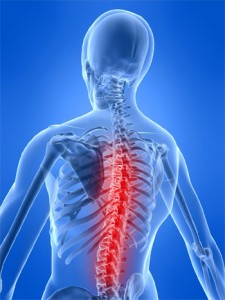 A spinal compression fracture is when there is a collapse in one or more bones of your vertebrae. Vertebrae are rounded bones that are stacked on top of each other down the middle of your back. Compression fractures of the spine happen when there is too much pressure on the vertebra. The vertebra collapses, and becomes wedge shaped instead of round. Spinal compression fractures can occur anywhere in the spine, but are most common in the upper back region.
A spinal compression fracture is when there is a collapse in one or more bones of your vertebrae. Vertebrae are rounded bones that are stacked on top of each other down the middle of your back. Compression fractures of the spine happen when there is too much pressure on the vertebra. The vertebra collapses, and becomes wedge shaped instead of round. Spinal compression fractures can occur anywhere in the spine, but are most common in the upper back region.
Many spinal compression fractures are caused by osteoporosis, sports injuries, and work place accidents.
Symptoms that can indicate a spinal compression fracture:
- Severe back pain that gets worse when standing or walking
- Pain when bending or twisting
- Muscle spasms in your back.
- Pain when the fracture area is touched.
- Sudden, severe, back pain.
- Sudden weakness in your arms or legs.
Risks for a spinal compression fracture:
- Genetics & Age: The risk is higher as you age and by having a close family member with a history of compression fractures.
- Bone mineral density: Having low bone density increases your chances of having osteoporosis
- Diet and exercise: Not eating foods rich in calcium and vitamin D, and not incorporate weight-bearing exercises such as walking or jogging into your daily routine.
- Lifestyle choices: Smoking and weighing too much increases your risk of getting a back injury.
- Medical conditions: Long term diseases, such as liver cirrhosis and diabetes
- Medicines: Taking medicines that can cause calcium to be lost from your bones, such as hormones, steroid medicine, and antacids
Treatment for a spinal compression fracture:
A spinal compression fracture can be diagnosed with a physical examination to determine whether a vertebra has collapsed.
If you have a compression fracture, you may need to rest in bed for a few days and take anti-inflammatory or pain medicine, however, within a few days of the fracture you will need to start some form of physical therapy. Physical therapy will help improve strength and decrease your risk for loss of function.
Depending on the severity of the fracture, you may need to wear a back brace for several weeks to help your vertebrae heal.
Physiotherapy:
Your health care practitioner will assists you to restore, maintain and maximize your strength, function, movement, and overall well-being by using natural methods such as exercise, motivation, adapted equipment and education. Physiotherapy helps improve movement and decrease pain.
Laser Therapy:
- improve circulation
- reduce inflammation
- improve transport of nutrients across the cell membrane
- influx of water, oxygen and nutrients to the damaged area
- reduce swelling, muscle spasms, stiffness and pain
Ultrasound:
- increase oxidation,
- reduce swelling & muscle spasms
- improve circulation
Massage Therapy:
- Improved circulation
- Elimination of toxins
- increase circulation
- increase your flexibility and range of motion
The first step is to contact your health care practitioner so they can diagnosis your condition, set up a treatment plan, and get you healthy and active as quickly as possible.


